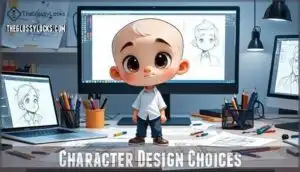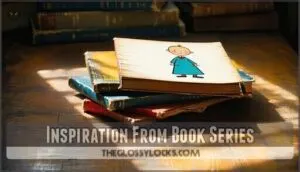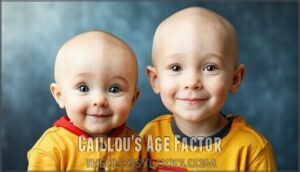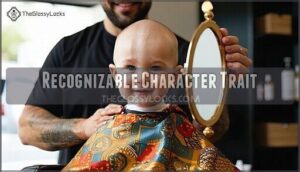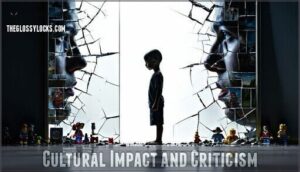This site is supported by our readers. We may earn a commission, at no cost to you, if you purchase through links.
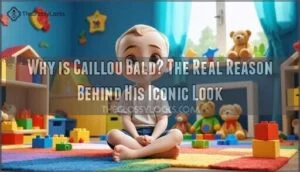
The answer’s simpler than you’d think – it’s a deliberate design choice, not a medical condition.
The creators wanted him to look like a typical toddler, and many young children don’t have full heads of hair yet.
Originally, Caillou appeared as a baby in the book series, and when they aged him up for TV, they kept his bald look to maintain his recognizable identity.
This design actually helps preschoolers relate to him better.
But there’s more to this iconic character choice than meets the eye, and it’s related to how the character was developed to have a lasting impact on young viewers.
Table Of Contents
- Key Takeaways
- Caillou’s Bald Origin
- Why Caillou is Bald
- Caillou’s Age Factor
- Medical Condition Rumors
- Recognizable Character Trait
- Animation and Production
- Cultural Impact and Criticism
- Frequently Asked Questions (FAQs)
- What’s the story behind Caillou being bald?
- Why is Caillou always 4?
- What race is Caillou?
- What is the Inspiration Behind Caillou’s Character?
- What Is the Summary of the Caillou TV Show?
- What Is the Caillou Books Series About?
- How Does Caillou’s Baldness Affect His Character Recognition?
- What Are Some Criticisms of the Caillou Series?
- Does Caillou ever grow hair in episodes?
- How do other characters react to baldness?
- Conclusion
Key Takeaways
- You’ll find that Caillou’s baldness isn’t a medical condition – it’s a deliberate design choice the creators made to keep him recognizable as he aged from baby to preschooler in the TV adaptation.
- You can thank practical animation needs for his bald look, since drawing hair would’ve increased production costs, required more complex animation frames, and taken away focus from his facial expressions.
- You’ll instantly recognize Caillou among other cartoon characters because his baldness became his trademark feature, helping parents and children identify him across episodes, books, and merchandise.
- You won’t see Caillou grow hair in any of the 200+ episodes because the creators prioritized character consistency and relatability with their preschool audience over realistic aging.
Caillou’s Bald Origin
You’ve probably wondered why Caillou doesn’t have any hair like other cartoon characters his age.
The answer lies in his original design as a baby character in the book series, where creators kept him bald to maintain his recognizable appearance as he grew older.
Character Design Choices
When you look at Caillou’s distinctive appearance, his iconic baldness wasn’t accidental.
The creators made deliberate character design choices to guarantee visual identity remained consistent. This animation simplicity helped the target audience recognize him easily across episodes.
Caillou’s baldness became his defining trait through careful design evolution. The caillou design prioritized recognizability over traditional character appearance expectations, making his caillou character instantly memorable.
Inspiration From Book Series
Caillou’s baldness stems from his Book Origins in French Canadian children’s literature. Christine L’Heureux’s Initial Concept featured an infant character, naturally bald like most babies.
The French Influence and Pebble Symbolism shaped his identity. When adapting the book series for television, creators maintained this caillou backstory to preserve recognition from childrens literature.
L’Heureuxs Choice established this iconic look:
- Original infant character design
- Natural baby appearance
- Book-to-TV consistency
- Reader familiarity preservation
Symbolism of Baldness
Beyond simple character design, Caillou’s baldness carries deeper meaning. His smooth head represents childhood innocence lost through daily struggles.
You’ll notice how his vulnerability aspect contrasts with societal norms about appearance. This purity symbol challenges typical power dynamics in children’s media.
Various Caillou theories suggest his hair loss symbolizes emotional growth, making his character traits more relatable to young viewers coping with their own developmental challenges.
Why Caillou is Bald
Understanding character design reveals the practical reasons behind Caillou’s baldness. You might wonder if there’s some deeper mystery, but the answer is surprisingly straightforward. Design simplification played a major role in keeping Caillou bald throughout the series.
Animation costs were substantially reduced by maintaining his hairless appearance. Adding hair would’ve required extra frames, movement patterns, and detailed styling for each episode. That’s expensive and time-consuming for animators working on tight budgets.
Character recognition became another key factor. Once audiences knew Caillou as the bald kid, changing his look would’ve confused viewers. His baldness became his trademark – like Mickey Mouse’s ears or SpongeBob’s square shape.
Cultural symbolism wasn’t the primary concern here. The creators focused on practical production needs rather than deeper meanings. Caillou’s hair loss isn’t about alopecia or medical conditions. It’s simply smart business wrapped in creative decision-making that shaped audience perception forever.
Caillou’s Age Factor
You might wonder why Caillou stayed bald even as he grew from a baby into a four-year-old.
The creators faced a simple choice: give him hair and make him unrecognizable, or keep his bald look for consistency across all ages.
Impact on Character Design
Caillou’s baldness substantially shaped his visual identity and memorability.
Design simplicity became the show’s foundation, making him instantly recognizable among bald cartoon characters.
You’ll notice his iconic appearance creates stronger relatability factor with young viewers who often have sparse hair themselves.
This character design choice prioritized memorability over realistic aging, ensuring Caillou cartoon remains distinctive across different episodes and seasons.
Aging Process in The Show
You’ll notice Caillou’s character progression creates timeline inconsistencies throughout the series.
His age jumps from two to eight years old across episodes, yet his appearance remains unchanged.
These developmental stages confuse audience perception since most children grow hair as they mature, and the show’s narrative impact suffers from this bizarre aging process where Caillou’s baldness persists despite normal character aging expectations.
Consistency in Appearance
When you think about maintaining recognizability across different ages, Caillou’s creators made a smart choice.
Aging character designs typically change dramatically, but his baldness keeps him instantly recognizable.
This visual simplicity creates animation efficiency while establishing an iconic feature.
Consider how this consistency works:
- Young viewers always know it’s Caillou, regardless of storyline age
- Parents don’t confuse him with other bald cartoon characters
- His caillou appearance remains memorable across episodes, which is due to his visual simplicity.
Medical Condition Rumors
You’ve probably wondered if Caillou’s baldness comes from a medical condition like alopecia or cancer. The truth is, his lack of hair isn’t connected to any illness at all.
Debunking Alopecia Claims
Despite online rumors about caillou alopecia or childhood alopecia causing his baldness, these autoimmune misconceptions aren’t accurate.
You won’t find official confirmation linking caillou hair loss to genetic predisposition or stress-related hairloss.
Fan theories suggesting why caillou bald stems from hair growth factors ignore the show’s website clarification.
These medical explanations simply don’t match the creators’ actual intentions.
Design Choice Vs Medical Condition
When examining Caillou’s baldness, it’s essential to separate fact from fiction.
His lack of hair isn’t a medical condition but a deliberate creative choice.
Here’s why this distinction matters:
- Animation Simplicity – Easier to draw and animate consistently
- Iconic Appearance – Creates instant character recognizability
- Design Consistency – Maintains visual continuity across episodes
- Baldness Symbolism – Represents childhood innocence and simplicity
- Production Efficiency – Reduces animation complexity and costs
The reasons listed above highlight the importance of Caillou’s baldness in the context of the show, contributing to its overall aesthetic and production efficiency.
Creators’ Intentions
The creators’ design philosophy centered on making Caillou relatable to their target audience of preschoolers.
Educational goals drove artistic choices, ensuring the character’s baldness wouldn’t distract from the show’s message about imagination and learning.
Caillou’s reason for staying bald was purely creative – the origin story explained that adding hair would compromise character relatability and recognition among young viewers.
Recognizable Character Trait
You’ll instantly recognize Caillou among hundreds of cartoon characters because his bald head makes him stand out from every other preschool show character.
This unique trait became his trademark feature, helping parents and children identify the show across different platforms and merchandise.
Baldness as a Distinct Feature
Caillou’s iconic bald head creates instant recognizability that few cartoon characters achieve.
You’ll spot him immediately in any crowd of animated kids. His baldness became a defining trait that sets him apart from typical hair-sporting protagonists.
This design consistency helps parents and children identify Caillou across different episodes, books, and merchandise, making his appearance unforgettable and culturally significant.
Impact on Show’s Branding
You’ll notice Caillou’s baldness became his strongest visual identity marker.
The animation team created instant brand recognition through this distinctive appearance. Marketing materials leveraged his memorable bald head across merchandise and promotional content.
This educational television show transformed Caillou into a cultural icon, where his baldness drives memorability factor more than typical childhood development storylines. His unique appearance guarantees immediate identification.
Cultural Significance
You’ve likely encountered Caillou baldness discussions across social media platforms.
His hairless head became a meme culture phenomenon, spawning countless online parodies.
Many view him as an ineptitude symbol and negative rolemodel, sparking heated online discussions about cultural representation.
This generational impact shows how why caillou bald remains relevant, transforming from children’s character into internet legend that defines childhood frustrations.
Animation and Production
You might think Caillou’s baldness was just a creative choice, but it actually served practical animation purposes.
The creators kept his head smooth to make drawing easier and reduce the time needed to animate each episode.
Simplifying Animation Process
Animation studios love shortcuts that work. Caillou’s baldness wasn’t just about character recognition—it made animation way easier.
Here’s how this Canadian cartoon benefited from design simplicity:
- Fewer lines to draw meant faster production schedules
- No hair movement to animate during scenes
- Streamlined production focused resources on facial expressions
This caillou reason shows how animation efficiency shaped why caillou bald became perfect for cartoon character development.
Studios could also leverage animation product resources to aid in production.
Reducing Production Costs
Beyond animation simplification, budget constraints played a major role in keeping Caillou bald.
Hair requires extensive design efficiency planning and resource allocation for each frame.
This Canadian cartoon’s creators chose streamlined production over complex hairstyles.
The caillou bald design reduced costs substantially, allowing more focus on storylines.
Smart budget decisions explained the caillou reason behind his iconic look.
These savings are related to cartoon budget reduction, which highlights the importance of cost reduction in cartoon production.
Focus on Facial Expressions
Caillou’s baldness freed animators to spotlight his facial expressions without hair distracting viewers.
You’ll notice how clearly his emotions shine through – every smile, frown, and surprised look hits harder.
This character design choice means you focus on what really matters: his feelings.
Without hair bouncing around, animators could perfect each emotional moment, making viewer interpretation crystal clear, which allows the audience to connect with his emotions on a deeper level, emphasizing the importance of emotional moment.
Cultural Impact and Criticism
You’ll notice that Caillou has sparked intense reactions from parents and viewers who criticize his behavior and the show’s approach to discipline.
The character’s baldness has become part of broader discussions about his negative influence, with many online reviews and memes targeting both his appearance and actions.
Public Perception of Caillou
Over the years, you’ve probably noticed that Caillou sparks intense reactions online. The bald four-year-old has become a lightning rod for parental concerns about children’s television.
His whining behavior and lack of consequences have fueled widespread caillou hate across social media platforms.
Parents frequently express frustration about the show’s influence on their kids:
- Children mimicking Caillou’s tantrum behaviors after watching episodes
- Increased whining and demanding attitudes in young viewers
- Concerns about the show normalizing bratty behavior without teaching proper consequences
Online Reviews and Memes
Something fascinating happens when you enter online spaces discussing Caillou – you’ll find endless memes and satirical reviews that showcase the internet’s collective frustration.
The online community has transformed Caillou hate into comedic gold, with viewer reception spawning countless parodies.
From satirical justice movements to review humor on platforms like IMDB, these internet memes prove how deeply the show has penetrated popular culture.
Controversy Surrounding The Show
Many parents can’t stand Caillou’s whining tactic and lack of parental discipline.
The show’s flaws have sparked intense caillou controversy, with viewers claiming he’s a terrible role model who encourages negative behavior. Despite rumors about caillou cancer or alopecia, the real hate stems from his bratty attitude, not his baldness.
Critics highlight several concerns:
- Children copying Caillou’s whining to get their way
- Parents failing to set boundaries or consequences
- Tantrums being rewarded instead of corrected
- Aggressive behavior toward siblings going unpunished
- Episodes lacking meaningful life lessons or growth
Frequently Asked Questions (FAQs)
What’s the story behind Caillou being bald?
The creators initially designed him as a baby with little hair.
When they aged him up, they kept him bald so you’d still recognize the character—it’s purely a design choice.
Why is Caillou always 4?
Caillou stays four years old because the show’s creators wanted him to remain relatable to their target preschool audience.
You’ll notice he doesn’t age, keeping the character consistent for young viewers.
What race is Caillou?
Looking at this beloved children’s character, you’ll notice he’s depicted as a white Canadian boy from Montreal.
His ethnicity isn’t explicitly stated, but his family represents typical French-Canadian culture through their setting and lifestyle.
What is the Inspiration Behind Caillou’s Character?
The beloved children’s character draws inspiration from Dr. Françoise Dolto’s pebble ritual, emphasizing children’s autonomy and respect.
You’ll find his Montreal origins reflect educational goals, promoting imagination and learning through relatable childhood experiences and developmental challenges.
What Is the Summary of the Caillou TV Show?
You’ll find this educational preschool series follows a curious four-year-old boy exploring daily adventures with family and friends.
He learns problem-solving, imagination, and social skills through relatable childhood experiences and gentle life lessons, including learning about imagination.
What Is the Caillou Books Series About?
You’ll discover the original book series follows a curious toddler’s everyday adventures in Montreal.
These stories explore childhood emotions, family relationships, and learning experiences that helped shape the beloved TV character we recognize today, including family relationships.
How Does Caillou’s Baldness Affect His Character Recognition?
A picture’s worth a thousand words, and Caillou’s bald head speaks volumes.
You’ll instantly recognize him across episodes because creators kept his hairless look consistent as he aged, making him unforgettable to young viewers.
What Are Some Criticisms of the Caillou Series?
You’ll notice critics slam Caillou for teaching kids that whining works.
Parents hate how he’s never disciplined for bratty behavior toward his sister, making him a terrible role model for children.
Does Caillou ever grow hair in episodes?
Over 200 episodes aired without Caillou sprouting a single strand.
You’ll never see him grow hair because creators deliberately kept him bald for consistency as he aged from baby to preschooler, maintaining his recognizable appearance.
How do other characters react to baldness?
Other characters in Caillou’s world don’t react to his baldness at all. You’ll notice his family, friends, and classmates treat him normally without comments or questions about his appearance.
Conclusion
Like peeling back layers of an onion, understanding why Caillou is bald reveals thoughtful character development rather than mystery.
The creators made a simple yet effective choice to keep his baby-book appearance when moving to television.
This baldness helps young viewers connect with him while maintaining his recognizable identity.
You now know the real story behind this iconic design decision. Caillou’s bald head isn’t about medical conditions—it’s about smart storytelling and character consistency that resonates with preschoolers worldwide.

